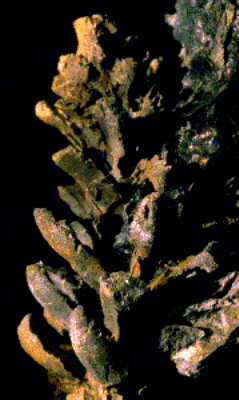 Three-dimensionally preserved
conifer twig of the genus Cassinisia from the Middle Permian of the
Southern Alps, Italy |
Late Palaeozoic Gymnosperms
The gymnosperms, or flowerless seed plants, are a group of plants which
first appeared in the latest Devonian. The conifers are the most widespread
recent representatives. Apart from the now still occurring groups and families, a
number of extinct groups and families are known. These include, e.g. the
pteridosperms, plants with a fern-like growth habit which reproduced with
true seeds. Before the first appearance of the flowering plants, or
angiosperms, some 110
million years ago the gymnosperms were often dominant elements of the flora.
Our research principally focuses on the gymnosperms from the Upper
Carboniferous and Permian. During this time the flora showed a strong
diversification, not only in a systematical sense but also ecologically.
Several groups first appeared, e.g., the conifers, the ginkgophytes and the
cycads, while others showed a rapid evolution. Research in Münster
concentrates on the earliest conifers and the pteridosperms. Important
aspects are the establishment of natural relationships between the
individual taxa and their ecology and functional morphology.
|